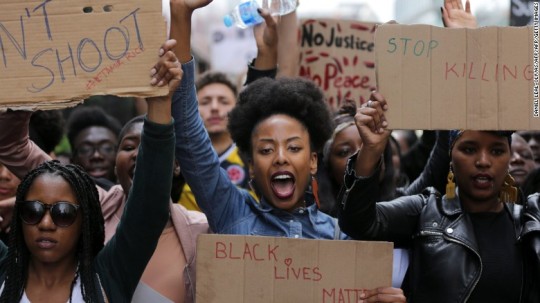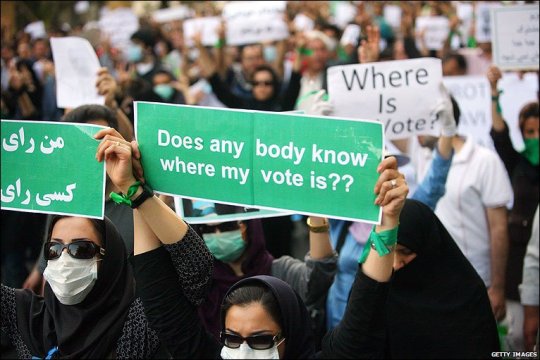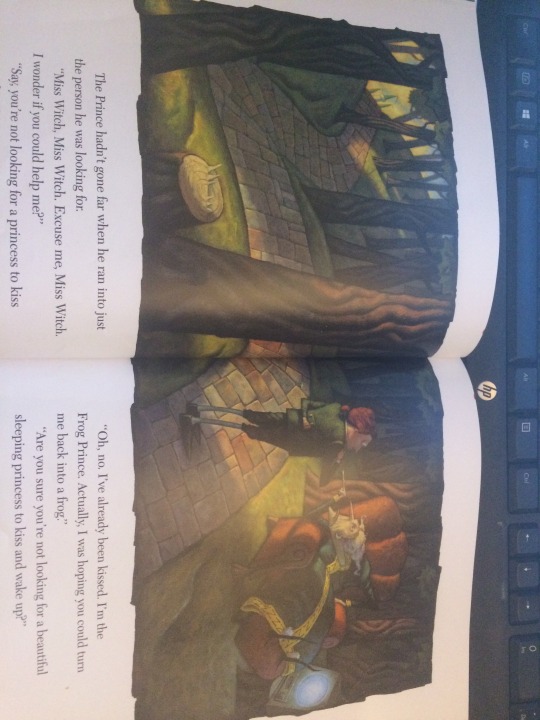#new york oberver
Text
Artcrime: What ‘Beware the Slenderman’ Says About Blaming Artists for Violence
There is no artist behind Slender Man, not in the panoptic, memetic form in which Morgan and Anissa encountered him. Slender Man’s “author” is the internet and the army of artists and writers and filmmakers and game designers who inhabit it. Only the accident of history, in which the original posts can be tracked down, enables us to put names to the faceless being at all. A few decades ago Slender Man would just be Bloody Mary or the killer with a hook for a hand who disrupts teenagers necking in their cars. A few centuries ago and he’d be the vampire a town feared enough to dig up graves and behead the corpses inside, or the witch who lures wayward children to their doom. With no artist in play, it becomes clear how fallacious it is to pin the blame on artists for the actions of disturbed individuals who consumed their art at all.
This is not to say art never affects society or inspires terrible things. When Jared Kushner crows about targeting ads for his odious father-in-law Donald Trump’s presidential campaign to viewers of The Walking Dead because of their concerns about immigration, he’s recognizing the fascist ideology that underlies both the show and the current administration. But art with an ideological vector connects the reader or viewer to a cohesive worldview, which, right or wrong, helps explain society and prescribe remedies for its ills. Action and reaction are to be expected.
That’s different from a movie about a pair of abused kids who become mass murderers and media superstars, or music by a glam-influenced Satanist, or creepy internet posts about a demon with no face. These merely provide monsters who embody fears and desires, not a political program. Those monsters will always exist in one form or another, and disturbed kids like Morgan and Anissa will always find them and use them as the mold into which they pour their crumbling sanity or mounting bloodlust. In blaming the art or the artist, we commit the exact same error, looking for a boogeyman to help us explain the inexplicable. We’re finding our own Slender Man to serve.
I wrote about the documentary Beware the Slenderman and when we should and shouldn’t hold artists to account for crimes inspired by their art for the New York Observer.
#beware the slenderman#slenderman#slender man#irene taylor brodsky#marble hornets#sean t. collins#new york oberver
75 notes
·
View notes
Text
Affective Publics - 4

Six years ago, in the wake of George Zimmerman’s acquittal in the shooting death of an unarmed black teen, and as increased cases of police brutality against African Americans made front-page headlines, a singular rallying cry ignited a modern-day movement for social justice. Black Lives Matter emerged, not from the raised voices of outraged citizens flooding the streets of American inner cities, but from a hashtag-bearing Facebook post. Soon, the declaration would spread far beyond our borders, resonating with marginalized people across the globe.
According to Pew Research Center, #BlackLivesMatter appeared nearly 30 million times on Twitter between July 2013 and May 2018 with usage spiking in response to coverage of officer-involved shootings. This effect speaks to what Zizi Papacharissi expounds upon in Affective Publics: how social media inspires civic engagement by allowing people to emotionally connect to current events. She cites several researchers (Dean, 2010; Gregg, 2011; Karatzogianni & Kuntsman, 2012; van Dijck, 2013) who credit social media with “activating latent ties that may be crucial to the mobilization of networked publics” (p. 8). These technologies help to unify disparate individuals around a common interest in ways that traditional media seldom did. They provide a space for small voices to project loudly, reaching audiences far and wide. In a 2016 New York Timesarticle, Lee Rainie, Pew Director of Internet, Science and Technology Research, spoke of the correlation between #BlackLivesMatter and the movement it inspired: “This is a very powerful example of how a hashtag now is attached to a movement, and a movement, in some ways, has grown around a hashtag — and a series of really painful and really powerful conversations are taking place in a brand-new space.”
While social media has expedited the communication process, the emergence of live feeds has enhanced its sense of immediacy, allowing obervers to virtually participate in moments as they happen. Papacharissi (2014) notes that this is not a completely new phenomenon, as broadcast journalism has transported viewers to remote locations for decades, triggering affective responses to various stories. However, she insists that “newer media follow, amplify, and remediate that tradition of storytelling” (p. 4). Indeed, while social media technology facilitates the formation of human networks, “it is narratives that connect us to each other, making us feel close to some and distancing us from others” (p. 5).

Like supporters of Black Lives Matter, global citizens take similar advantage of social media to express discontent with political leaders and social conditions. In countries where state censorship seeks to suppress media access, citizens use social media to subvert traditional forms of communication, as demonstrated by the 2009 presidential election protests in Iran (Papacharissi, 2014, p. 37). The sharing of these moments and their subsequent commentary often cause emotional responses; such affect “conveys the intensity with which an opinion is felt, and when expressed, it can intensify the sense of empowerment experienced by the individual releasing a thought, emotion, or act to the public” (p. 113).
While the author paints an impressive picture of social media’s power to bridge gaps and build alliances in support of the common good, too often technology is instead used to cause division and discord, especially in American society and culture. A recent pollfound that more than 59 percent of U.S. teens have experienced some form of cyberbullying, while 47 percent of American adults admit to being harassed online (Pew Research, 2017). Despite these sobering statistics, here’s to hoping that one day the good will outweigh the bad, that all users will engage social media as responsible citizens, allowing each platform to reach its fullest potential.
0 notes
Photo

Quality Illustration
Scieszka, Jon. (1991). "The Frog Prince Continued". New York. Penguin.
This picture book follows the Frog Prince and his wife, the princess who turns a frog into a prince by kissing him in the classic fairy tale. While, they are supposed to be living happily ever after, the couple does not get along as the princess finds the prince's "frog" habits to be annoying. The prince leaves in search of a witch to turn him back into a frog. After running across several witches from other fairy tales, he comes to appreciate his new life with the princess after all. The illustration I'm focusing on involves the frog walking through the woods and finding the Witch of the "Sleeping Beauty" witch. The art is drawn with modern Gothic elements. The characters have plump bodies and thin, long arms and legs--simililar to a frog's. Bright colors are not used, instead Steve Johnson chooses greens and browns to bring on the feeling of being in a swamp. In the illustration, the prince introduces himself while the witch points a long, bony finger at him. Taking a closer look at her robe she is wearing, one can see that there are "Z"s in the pattern, giving a clue that she is the "Sleeping Beauty" witch. The dark forrest that surrounds them is similar to the characters as the trees have thick trunks and thin branches.
There is no clash in style, so the illustration has a somber mood to it. We get to see the entire expanse of the forrest as the illustration is from the perspective of an outside oberver wathcing this story unfold. Readers can infer the witch's nasty intentions because of her mean demeaner, long pointy fingers, and a classic witch's nose. In the scene, she is watching a snow covered telivision set, which clashes with the Mideval time setting. This could be a clue to a reader that this story is not your average story, but a modern perspective to a fairy tale. It may also demonstrate to the reader that the witch does not do much but watch television. The prince looks hopeful. Afterall, this is the first witch he encounters so he still has hope that the rest of the journey will be fruitful. His smile and her scowl contrast each other to show their emotion. This illustration would appeal to a child mostly due to the fantastical landscape. The dark forrest is a theme of several common fairy tales and it is very prevalent here. The illustration does not, however, present itslelf as too dark or ominous by including the fun interaction between the prince and witch.
-Dan Stutting
1 note
·
View note
Text
A Reporter, Alexander Skarsgard and a Bathroom?
A fun, little article appeared on my Google Alerts straight from The New York Observer about a guest appearance of my favorite actor Alexander Skarsgard at some event during Fashion Week. I'm first going to tell you what I liked about the article and then I'm going to give you the appropriate eye-roll comments. The writer definitely captures Alex's great sense of humor when he asked him how he got there and Alex gave the perfect smart-ass reply by the elevator. I nodded and appreciated his sense of humor in messing with the reporter. He must have been in a good mood. And the recent pictures taken of him lately he has seemed in very good spirits, which is nice to see. Their playful banter continued with more smart-ass replies, but I'll let you read the article for the details. And any true and sarcastic smart-ass is a guy to love, but only if it's harmless and fun. I'm not a fan of mean-spirited smarty remarks. All right so here comes the eye-roll commentary:did the reporter really need to dish on the trip to the urinal? Really? Is nothing left that is sacrosanct anymore? Since when did we need to know they trekked off together to the bathroom? I guess I'm just a good old-fashioned writer who thinks some thing need not be "reported" on, and I'm willing to suggest the reportage of bathroom discussions wasn't really necessary. Well, to end my little commentary here this morning, I will say that as is almost always the case when I read these things, the gracious Mr. Skarsgård gave the reporter an apparent pep talk on how to meet women. The fact that the reporter also called him the "nicest vampire" is just another confirmation of what I've recognized already and a friend I met of his at a recent party also said, "He is very nice!" Love it. Unlike some women, I adore nice, gracious, kind and thoughtful men. You go Alex! All that great karma is going to serve you well, as it is already.
1 note
·
View note